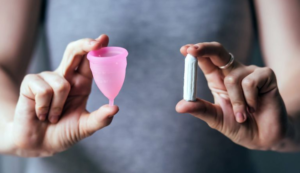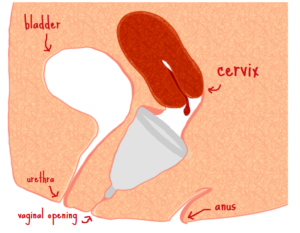
Why a menstrual cup?
Women go through an average of 11,000 tampons in a lifetime according to Campaign for Safe Cosmetics. With an average cost of $7 per box with 36 tampons, that works out to being over $2,000 spent on hygiene products. Use a pad instead? You have a comparable result. These products create landfill waste, cause plumbing problems when flushed, and contain a myriad of chemicals that not only pollute the environment, but your body as well. The tissues of the vagina are great at absorbing these pesticides, chlorine, dioxins, etc. In fact, the external vagina is a common route of medication application (such as bioidentical hormone creams). You can avoid many of these ingredients by purchasing organic tampons, but the cost is higher and none of the other downsides of tampon use are resolved.
I have been routinely surprised by how many of my patients have not heard of, or taken the leap to try, menstrual cups. There are many brands out there. All have the same basic function: to collect, rather than absorb, menstrual blood. These reusable silicone or latex rubber devices run around $40. Although it is a larger up-front cost, some companies suggest their products can be used for 10+ years. This makes menstrual cups not only more economical, but also better for the environment and your health as the user.
How is it used?
The cup is folded and inserted like a tampon so that it creates a seal against the walls of the vagina. Once placed, it may unfold itself or you may need to rotate it until it opens completely. When properly positioned the wearer should not feel it, experience any discomfort, or get leaks. I always tell my patients to use a pad for the first 2 cycles of use, so they can get accustomed to the cup without mishap.
To remove the cup, pull on the tab at the bottom which should be within reach. If you have difficulties reaching the tab you can always bear down. If you have an IUD or use a NuvaRing, you can still use a menstrual cup though it is ideal to break the suction of the cup before trying to remove it so the other device is not dislodged. The risk of an IUD coming out with a menstrual cup is only slightly higher than it being expelled on its own.
Menstrual cups can be left in for up to 12 hours (unlike a tampon) and are reusable. When you go to empty the cup, just rinse with soap and water and replace it. Due to the need to wash the cup, it is more convenient to be in a restroom with a sink within reach. You can make public restrooms work but you might get your hands a little messy.
How is it cleaned?
After your cycle you can use the washes that are advertised by the menstrual cup companies or most can be boiled for 3 minutes to sterilize. When staining starts to occur, the cup will function the same, but you can also treat it with a homemade hydrogen peroxide solution:
• 1/3 hydrogen peroxide and 2/3 water
• Allow to soak for 5-10 minutes
• Wash the cup well after to remove hydrogen peroxide remnants
What size?
Many of the menstrual cups come in different sizes listed as A/B or S/M/L or 1/2. The larger cups are advertised for women who have had children via C section or vaginal delivery, but many women state they are fine with the smaller sizes. Women with heavier bleeding may want to get a larger cup for convenience matters. The following is a link to a quiz that advertises it can determine the right menstrual cup for you: https://putacupinit.com/quiz/. Fair warning, I have not fully vetted if their results are accurate.
How is one purchased?
Lunette and Diva cups seems to be the most popular brands. You can purchase both online or support local Tacoma and Federal Way businesses by making your way to Marlene’s Market and Deli. They have the Lunette cup in stock and for sale for the same cost as online, around $40. The Diva cup is slightly less expensive at $32, but the tab at the base of the cup is not as user-friendly.
Further questions?
Make an appointment and consult your provider here at the Holistic Health Clinic! And yes, you can urinate while wearing a cup. See anatomy diagram below:

Written by Dr. Julia Miller, ND
(August, 2018)
References
Reporter, N. E. (2017, July 24). Women slowly embrace use of menstrual cup. Retrieved from New Era Newspaper
Straus, R. (2018, May 16). 6 Things That Happened When I Switched From Tampons To The
Menstrual Cup. Retrieved from https://www.goodhousekeeping.com/health/a20706324/switching-from-tampons-to-menstrual-cups/
Put A Cup In It. (2018, March 12). We know your perfect menstrual cup based on 9 questions!
Retrieved from https://putacupinit.com/quiz/


